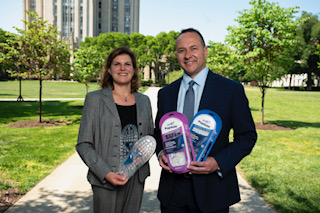
By: Samuel Fogel, KLN '24
How were you introduced to the podiatric field, and what led you to TUSPM?
“My father is a podiatrist and I followed in his footsteps. I always wanted to be a doctor but didn’t know what kind, so my father had me try different specialties. I spent time with an anesthesiologist, but I wanted to build more of a relationship with the patient. Next, I spent some time with a pediatrician, but that wasn’t for me either. Then I spent time with my father at his practice and, I was fascinated by the medical and surgical opportunities and enjoyed the patient variety from pediatric to geriatric. My father, my ultimate guide and hero said the education I would get at TUSPM would be second to none. I visited and was sold.
What was your experience like at TUSPM?
“Academically, temple was exceptional. I feel so privileged to have been taught by some of the giants of podiatry. They provided me with an excellent foundation in surgical technique in addition to biomechanical function. One of the most poignant parts I’ve found in my career is that comprehending biomechanics sets podiatry apart from any other field. Understanding foot function and anatomic etiology allows proper procedure choice. Surgically, I felt very prepared for residency through the academia, clinical rotations, and externships I was exposed to by TUSPM. The skills provided to me by Temple and augmented by my residency gave me a more global perspective to tailor my treatments towards the patients and their needs.”
Tell me a little about your career path.
“I did my residency at Saint Barnabas in Livingston New Jersey. After residency, I joined Westside Podiatry Group in Rochester, NY and had the honor of working with my father, Dr Ronald Freeling for 12 years. After marriage I moved to Pittsburgh with my husband Dr Jeffrey Gusenoff. He was recruited by the University of Pittsburgh Plastic Surgery Department for body contouring after weight loss. We married our specialties and became the Co-Directors of the UPMC foot fat grafting program. We ran five clinical trials studying autologous fat grafting to the forefoot, rearfoot and for chronic plantar fasciitis. To make our procedures more efficient and improve the experience for both the patient and Doctor, we have innovated two medical devices. One to help process the fat more quickly and the second device is a customizable air-filled recovery insole."
What inspired/led you to starting your own business?
“Well, Jeff and I are avid Shark Tank watchers and are mesmerized by the entrepreneurial world but what also inspired us to start our own businesses is when we began prototyping our devices, entering competitions, engaging in grants, and validating our devices through research, the positive feedback was overwhelming. Our customer discovery and market research proved there was a real need for our innovations. We have therefore licensed our intellectual property from the University and have started two medical device companies. We are currently fundraising and preparing for the 510 K process for our fat grafting device and our customizable, versatile, air filled, waterproof recovery insole is on the market.”
Do you have any advice for recent graduates/first years at temple?
“Somebody gave me this advice in residency, and I think it is indispensable: you see what you know. You really do have to keep educating yourself through conferences, journals, webinars etc. Soak in what’s out there because when you’re evaluating a patient, if it’s not in your memory bank, you might not see it. If a peer, a teacher, a mentor, anybody asks if you want to be exposed to something new, take advantage of that.”
What is your favorite part of the podiatry field?
“Being able to keep people walking, upright and active more comfortably, is so rewarding. I feel like the feet are forgotten about until they hurt. A common patient phrase is “when my feet hurt, I hurt all over”. As a Podiatrist, if I can limit foot pain and keep a patient ambulatory and engaging in activities they love, it helps them mentally and physically from head to toe. That’s the best!”



